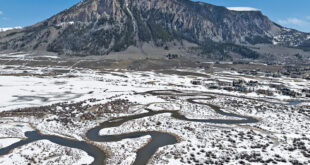I remember having the chance to do an interview several years ago with former President Jimmy Carter, who used to regularly visit Crested Butte for one of his charity events. At the time, there was some tension between two groups in town. Given that he had negotiated a peace treaty at Camp David between the Israelis and Egyptians (no easy feat), I asked him what he felt was the key to successful negotiations and collaboration.
A few of the main points he emphasized were that successful negotiations have to be personal and not exclude emotions. All parties have to be involved. Not being afraid to use creative approaches to get out of stalemates is important. And he emphasized that negotiations should start with a focus on what the two opposing parties agree on.
Talks have reopened between U.S. Energy, the company holding the molybdenum mining rights beneath Red Lady, and those in the valley who have concerns about that idea. USE is also legally responsible for operating the wastewater treatment plant and cleaning up the old Keystone Mine site. USE has proposed using a VCUP (Voluntary Clean Up Plan) to treat the water coming from the Keystone mine. The local groups are wary but open to the suggestion if it is done in an extremely responsible manner.
Last week, executives and lawyers of U.S. Energy sat down in their Wyoming boardroom with representatives of the town of Crested Butte, the Red Lady Coalition and High Country Citizens’ Alliance. This was the first real “sit-down” between the parties since at least last fall, when the company sprung the VCUP surprise on the community. That move didn’t go over well and ended whatever chats were going on between the company and the town.
Everyone involved in last week’s talks said the session in Riverton went well. The fact that traditional USE nemesis HCCA was invited to the talks was a big step in the right direction and speaks to one of Carter’s points. Involving everyone while forming personal relationships does matter.
No one said a final solution to the issue was close or even discussed last week but the fact that all the parties on both sides of the issue were talking about the common ground was a positive start.
Watching the company website and stock information, it appears USE is transitioning to less a hard rock mining company and more of an oil and gas company. That might be something that benefits both sides. It may help lead to a creative conclusion. Oil and gas seem to be doing a lot better financially than moly, which is plentiful, and not a rare earth mineral or even a rare mineral. There is a plenty of moly everywhere. There is honestly no immediate threat of a new start-up molybdenum mine anywhere in this country, let alone the middle of the Rocky Mountains three miles west of Crested Butte.
But if everyone involved in these new talks can creatively rid themselves of what they see as some sort of liability—for USE spending millions every year on a wastewater treatment plant at a nonworking mine, and for the local community, a constant looming black cloud of a threat to our water, economy and lifestyle—we could be on the way to fruitful talks. There is still the deep and dirty nitty gritty to get to but President Carter made it clear that such talks have to start with some sort of commonality. It appears that was done. And that can set up the bruisingly honest talks that will have to be held at some point between all the parties.
If the two sides can help each other achieve separate but mutually beneficial goals, this trip to Wyoming would be worth its weight in gold—which is worth a lot more than molybdenum right now.
 The Crested Butte News Serving the Gunnison Valley since 1999
The Crested Butte News Serving the Gunnison Valley since 1999




